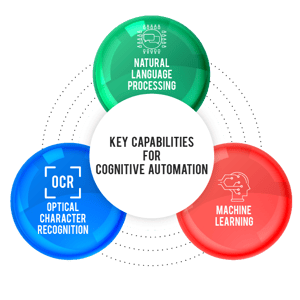Tech Talk: Using NLP as an Anchor for Automation
 Right now, “Preserve Cash” is the call to action for all companies. But when you look closer, there’s something way bigger at work.
Right now, “Preserve Cash” is the call to action for all companies. But when you look closer, there’s something way bigger at work.
“COVID-19 has created an imperative for companies to reconfigure their operations, and an opportunity to transform them.[…] After switching to daily planning cycles and gaining real-time visibility of their operations, managers don’t want to return to the old cadence of monthly planning and metrics that lag behind the situation on the ground.”[i]
On the other hand, the technology for solving these problems is far from trivial. A recent Gartner report includes the following list of technologies that would allow an enterprise to digitize their operations:
This is great advice and it is the reality – that’s how complex the problem is!
At the same time, this is enough to make someone dizzy.
The complex bundle of a machine that connects all your existing Systems of Record to orchestrate and execute workflows, provide recommendations, and understand how to contact stakeholders—your ERP, your CRM, your communication tools—is not something that a business user is looking to master.
If the machine must incorporate all these technologies, do I as a business user need to know about all of it?
Can’t the machine just do the job and get me the results?
Can’t I just ask the machine to take care of Invoice Accruals as needed? Or forecast my cash flow? Or run an AP helpdesk?
We looked for a way to hide this complexity from the business user and to offer a simple and intuitive way to communicate with the machine. We took close notice of the user experience. How would a business user delegate a task that represents a business process? How would they want to see the progress and the results? And we have realized that—they want to use plain English for all that.
- Automation must be simple to use. Tell the machine what you want in plain English, have the machine reply in plain English. If the machine needs to communicate with other humans to achieve a task, it should do it in plain English. No diagrams, no algorithms, no drag & drop connectors.
- Automation must be easy to start with. Say you want to want to transform your operations. Start with something simple, like automating your invoice accruals or your cash flow forecasting, while having the ability to automate any other process in the future, with the same approach, just by adding onto what you've already got.
- Automation must adapt easily if conditions change. Say your company has just acquired a competitor and you are tasked with integrating their systems and business processes. If your automation is based on a System of Engagement like Auditoria, just connect it to their existing Systems of Record—their ERP, CRM, and any point solutions—and you’re up and running.
- Automation must integrate seamlessly with all your other key tools. There are three tools that no enterprise accountant can live without: Email, Excel, and ERP. What do these tools provide?
- ERP is the key system of record. That’s where the financial data lives and where books get closed.
- Excel is the Swiss Army knife of any finance team.
- And Email—well, how can one contact anyone these days to request data without it? Think of most business processes in accounting and auditing. They involve multiple stakeholders that communicate between themselves to exchange information. These transactional business processes are the meat and potatoes of enterprise finance.
The same team of Gartner analysts had great advice in that same report:
“To realize business value, you must deploy AI technologies that deliver specific, measurable business outcomes for targeted use cases.”[ii]
We focused on Finance teams, which are under constant pressure—and would like to use an off-the-shelf offering—a way to automate their specific accounting and auditing business processes.
We took their key business processes and templatized them, creating SmartFlow Skills, while allowing for customization.
 Under the covers, we have included all the mandatory technologies, such as workflow engines to keep track of long-running processes, iPaaS-type on-demand ETL for moving and syncing data and records across diverse repositories, APIs, Natural Language Processing for both understanding text and generating questions or replies, low code/no-code platform capabilities allowing on the fly automation of new/custom business workflows, and pre-trained ML models for quantitative forecasting which outperform any standard forecasting tool in terms of accuracy.
Under the covers, we have included all the mandatory technologies, such as workflow engines to keep track of long-running processes, iPaaS-type on-demand ETL for moving and syncing data and records across diverse repositories, APIs, Natural Language Processing for both understanding text and generating questions or replies, low code/no-code platform capabilities allowing on the fly automation of new/custom business workflows, and pre-trained ML models for quantitative forecasting which outperform any standard forecasting tool in terms of accuracy.
That’s the Auditoria Platform.
Come talk with us if you’re interested to learn more!
[i] McKinsey “Jump-starting resilient and reimagined operations”, May 11th, 2020
[ii] Gartner “Move Beyond RPA to Deliver Hyperautomation”, December 2019, by Saikat Ray, Cathy Tornbohm, Marc Kerremans, Derek Miers.
